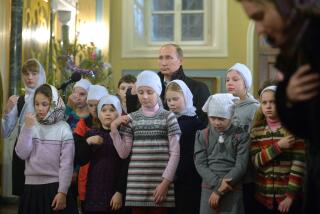Soviets to Get Allowances, Starting Now, to Ease Impact of Price Boosts : Kremlin: About 85% of the revenue from the higher prices will be returned to consumers.
- Share via
MOSCOW — The Soviet government promised consumers Wednesday that, starting immediately, they will be given monthly allowances from the state to lessen the impact of across-the-board price increases next month.
In an attempt to curtail the public protest over the first broad retail price increases in decades, the government will return to Soviet consumers about 85% of the revenue from the higher prices, Deputy Prime Minister Vladimir I. Shcherbakov told a news conference.
Shcherbakov said the increases were several years overdue because the government did not have the courage to take such unpopular action earlier, and as a result, the country’s economy has been all but destroyed.
Even during the recent economic reforms, the government had tried to avoid raising prices, Shcherbakov said, but “got only headaches and more pressure on the national economy. These were the only gains during this procrastination period.”
The increases, which go into effect April 2, were characterized by Shcherbakov and other top officials as the start of the long-awaited price reform needed to propel the Soviet Union’s collapsing planned economy toward a market system based on supply and demand.
But the government will continue to regulate, although in varying degrees, the prices for most consumer goods.
What the measures did, however, was to replace the old system of subsidized prices with a new system of income subsidies, which will be based on family need, numbers of children and profession.
This compensation will cost about 300 billion rubles, about $555 billion at the official rate of exchange, in 1991; a third of that will come from the national budget and two-thirds from the country’s 15 republics.
Under the plan, which was first proposed last month by Prime Minister Valentin S. Pavlov, prices will be increased by an average of 60% to 70%.
The government will continue to set prices on about 55% of the goods, including staples like milk, meat, flour and sugar. A further 15% will have state-set ceilings.
The remaining 30%, including leather goods, silks, wool, watches, some household appliances and electronic equipment, will be “free.” But stores will be allowed to charge no more than 20% over the factory price. The government will have the right to take an item off the free-price list if prices soar above what it considers acceptable.
Shcherbakov said the government could not continue with the old system of subsidies. Under the higher wholesale prices that went into effect last year, the state would have had to pay 240 billion rubles ($444 billion at the official exchange rate) in subsidies this year, he said.
Without the increases, the subsidies could have equaled about half the cost of all retail goods and services this year, according to Vladimir Gribov, the deputy chairman of the state plan.
“At the prices used today, there is no impetus to produce most consumer goods,” Gribov said. “Approximately 80% of goods are unprofitable and bring about losses when produced. . . . We are in a situation where the more goods we produce, the poorer we become.”
The higher prices are also intended to increase productivity, which has plummeted in recent years and drastically reduced the goods available in Soviet stores.
Shcherbakov acknowledged there would be some short-term inflation as a result of the increases, but he contended that the black market would grow and inflation would be far greater without them, since there would be fewer goods available.
“If production is not increased, then we will not be able to avoid large-scale inflation,” Shcherbakov said. “We have to try to make the producer interested in raising the amount of production.”
Alexander Nosov, deputy chairman of the State Committee on Labor and Social Affairs, said the government expects that workers and managers at manufacturing plants will be motivated by the higher prices to work harder because the compensation they will get from the government will not let them buy everything they want.
“We believe the minimal compensation will compel people to work more and better,” Nosov said. “We believe employees of manufacturing enterprises will have additional incentives to work more in order to earn more and be able to buy the goods they want.”
The elaborate system of monthly allowances or compensations that has been designed to accompany the price boosts resembles, in some ways, Western welfare systems, but it will assist everyone, not just the poor.
The state also used the compensation system to raise wages of doctors, teachers and service workers with particularly low salaries.
The average monthly compensation to wage earners will be 60 rubles ($111). The average urban worker’s pay is now 280 rubles a month.
Teachers, doctors and social workers, whose income does not depend on production, will be given allowances equal to 60% to 70% of their earnings, while compensation to workers at manufacturing plants will be only about 25% to 30% of their current take-home pay.
Families with children will get additional allowances. All families will receive an extra 50 rubles ($92.50) per month for children under 6, 60 rubles ($111) per month for children from 6 to 13 and 70 rubles ($129.50) per month for children from 13 to 18. Once a year, families will be given between 200 rubles ($370) and 280 rubles ($518) per child, depending on age, especially to buy “children’s goods.”
After a baby is born, a family receives 250 rubles ($462.50) in a lump sum and then 110 rubles ($203) per month until the mother goes back to work. Single mothers, families of military personnel and families with wages below the poverty level will get extra compensation.
Stipends for college students will be increased about 150%, and pensions will be raised by at least 50%, Nosov said.
More to Read
Sign up for Essential California
The most important California stories and recommendations in your inbox every morning.
You may occasionally receive promotional content from the Los Angeles Times.










